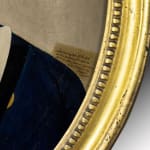Spoilum (fl 1770-1805) – Portrait of Captain George Delanoe, RN
50 x 42 cm
Further images
Provenance
By descent in the family of the sitter’s mother, Dorothy Harnage, to George Harnage of Cambridge. Sold with George Harnage’s handwritten history of the events. Harold Ward of Grantham.Inscribed and dated verso: ‘Geo. Augustus Delanoe Capt. Royal Navy 1794’, with inscription recto: ‘Captain Geo. Delanoe RN 1794’; and further inscribed by George Harnage in 1842 above opposite shoulder in another hand: ‘Lost his leg by a 32lb shot at the Mutiny of the Nore on June 10. 1797, when in command of His Majesty’s Ship Repulse 64 guns’. In original oval gilt frame.
An oval head and shoulders portrait of the Royal Navy Captain George Delanoe, wearing a blue coat with gilt buttons.
With a facsimile of the handwritten note detailed below printed on a protective perspex sheet on the reverse.
The handwritten note, which is signed and dated – ‘George Harnage, Cambridge, April 14 1842’ – states: ‘George Augustus Delanoe Captain Royal Navy, died unmarried January 10 at Linsted in Kent. His mother’s name was Dorothy Harnage, the eldest sister of …. Grandfather Colonel Harnage who married the Reverend John Delanoe of Guernsey. Captain Delanoe was first Lieutenant and commanding officer of His Majesty’s ship Repulse of 64 guns, and as stated in Captain Brenton’s Naval History 1. vol, page 437, on June 10, 1797, at three o’clock in the afternoon he lost his leg by a 32lb shot (now in my possession) fired from the Rebel Admiral Parker’s ship. The Repulse being the second ship which broke away from the mutiny at the Nore on the above day – The Leopard of 50 guns being the first.’; ‘O Lord I at all times most fervently pray we may each day be better prepared to meet thee’; ‘at my Grandfather’s decease in 1826 I came possessed of this picture’; ‘He was buried at Linsted on January 31. 1802. Brenton’s Naval History I have’.
This portrait by the Chinese artist known in the West as ‘Spoilum’ has all the characteristics, mannerisms and techniques associated with his portraiture.
Captain George Augustus Delanoe, RN (1762-1802): was the son of John Delanoe of Guernsey and Dorothy Harnage (1726-1807, married 1758). He was first Lieutenant and Commander of HMS ‘Repulse’, a third rate ship of the line of sixty four guns. During the Mutiny at the Nore on 10th June 1797, whilst escaping from the mutineers Delanoe lost a leg by a shot fired from another vessel. He was awarded a pension and later promoted to Captain although he did not live long enough to assume the rank. Delanoe was buried at Lynsted, Kent.
Spoilum (active 1770-1805): was a Chinese painter who painted portraits of Chinese and Westerners at the port city of Guangzhou, formerly Canton, from the 1770s until 1805. His name was also given as ‘Spillem’ or ‘Spilum’. His Chinese name is unknown, but it is possible that Spoilum was the artist now known in contemporary Cantonese records as ‘Guan Zuolin’. It is thought he began painting oils on canvas in the 1780s, being possibly the first Chinese artist to do so, instead of using the more usual Chinese style of inks on paper or silk. As Guangzhou was the only port at which Westerners were allowed to trade at this time, such works are likely to have been produced for the Western market. Spoilum had connections with not only the British, but also with the American trade through Guangzhou, and a number of his works are now held in American collections including the Peabody Museum, Salem, Massachusetts.
This portrait painting is directly comparable to other bust length portraits of British and American merchants, captains and members of the Honourable East India Company (HEIC). In his book ‘The Decorative Arts of the China Trade’, Carl L. Crossman illustrates a portrait of an unidentified Englishman in a red coat – an oil on canvas in an original Chinese frame – painted by Spoilum in 1786 (Carl L. Crossman, ‘The Decorative Arts of the China Trade: Paintings, furnishings and exotic curiosities’ (Antique Collectors’ Club, 1991), Colour Plate 5, p.38). Crossman comments that: ‘[t]he oval format is known in any number of portraits including the man from Dorchester (Plate 12), members of the British East India Company (Plates 10 and 11) and the portrait of Captain John Watts.’ He explains that: ‘the characteristics of Spoilum’s distinctive style are all present: the slight smile to the mouth, the grey background with the shadow behind the head, one eye slightly higher than the other, and the crisp delineation of the facial features’ (ibid, p.36). These hallmarks are all evident in this painting.
In addition, the support behind this painting is the same ‘cheesecloth-like canvas mounted on laminated wood stretchers’ which Carl L. Crossman also describes in ‘The Decorative Arts of the China Trade’, and the original gilt frame matches those used to frame Spoilum’s portraits. ‘A man from Dorchester, Massachusetts, by Spoilum’, dated from the late eighteenth/early nineteenth century is also illustrated ibid, plate 12, p.48. This gentleman is portrayed with the same facial characteristics as shown in this painting and Crossman states that: ‘[h]is hair style, swept up in front and longish at the back, was popular with Americans and English around 1800.’ (ibid, p.48). It also shows the characteristic pale section above the sitter’s left shoulder, which appears in Spoilum’s portraits. Plate 10 shows a Member of the British East India Company, dated circa 1800. Crossman depicts the reverse of the painting, showing the manner in which it has been framed.






